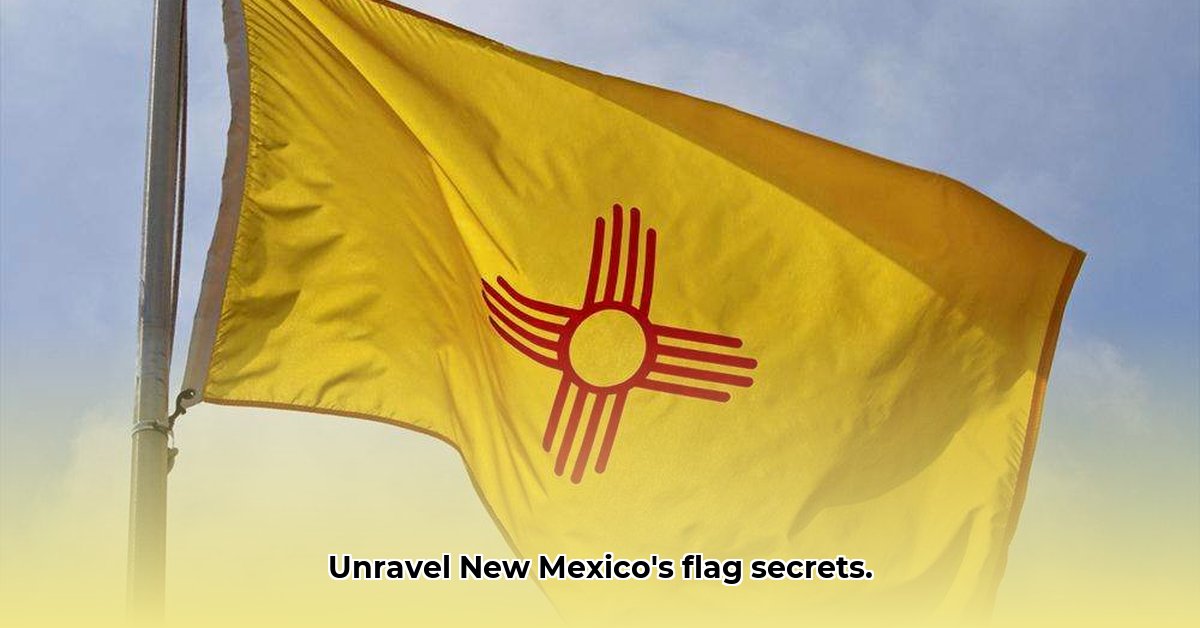Have you ever stopped to really look at the New Mexico state flag? It features a striking red Zia sun symbol emblazoned on a field of gold. But there’s so much more to it than just aesthetics. This flag tells a story of cultural heritage, historical complexities, and ongoing conversations about representation and respect. We’ll explore the origins of the flag, the profound meaning of the Zia symbol to the Zia Pueblo people, and the ethical considerations surrounding its use. Get ready for a deep dive into a piece of New Mexico history that continues to evolve.
The New Mexico State Flag: A Tapestry of History and Culture
The New Mexico state flag – a vibrant red Zia sun set against a golden backdrop – is more than just a state emblem; it’s a visual representation of a complex historical narrative. Adopted in 1925, the flag embodies the spirit of New Mexico, blending its Native American and Spanish influences. However, beneath its aesthetic appeal lies a story of cultural appropriation and the ongoing quest for reconciliation. Understanding this context is essential to appreciating the flag’s significance.
While the flag’s design seems simple, it represents a long journey to find a symbol that truly reflected the state’s identity. Early iterations lacked a distinct New Mexican character, mirroring other state flags of the era. The adoption of the Zia sun symbol marked a turning point, creating an emblem that became synonymous with “The Land of Enchantment.” But this seemingly harmonious blend of cultures also ignited a debate that continues to this day.
The Sacred Zia Sun: A Symbol of Life and Harmony
At the heart of the controversy is the Zia sun symbol. To the Zia Pueblo, an indigenous community deeply rooted in New Mexico, this symbol is far more than just a decorative motif; it’s a sacred representation of their core beliefs. The four cardinal directions, the four seasons, the stages of life, and the spiritual dimensions all converge in this powerful emblem. Imagine a symbol that captures the essence of their worldview, embodying balance, harmony, and the interconnectedness of all things. This symbol represents a worldview.
A Flag’s Contentious Origins: Appropriation and its Aftermath
The central issue lies in the way the symbol was adopted. The flag’s designers incorporated the Zia sun without obtaining explicit consent from the Zia Pueblo. This omission sparked a complex and ongoing debate about cultural sensitivity, respect, and the ethical implications of using a sacred symbol without permission.
The motivations of the designers are a matter of conjecture, but the impact on the Zia Pueblo is undeniable. The act, however unintentional, initiated a dialogue that continues to this day. Some argue the symbol’s adoption was a well-intentioned tribute to New Mexico’s rich history, while others emphasize the ethical implications of using a sacred symbol without consent, highlighting the power imbalances at play.
Beyond Borders: The Flag’s Enduring Presence
The New Mexico state flag’s influence extends beyond the state’s borders. It appears on military uniforms, official documents, and countless other items, solidifying its symbolic presence and amplifying the ongoing concerns raised by the Zia Pueblo. The USS New Mexico, proudly displays the flag, extending its reach to a worldwide audience. How does the flag’s global presence affect the Zia Pueblo community?
Charting a Path Forward: Dialogue, Understanding, and Reconciliation
The future of the New Mexico state flag hinges on open and honest dialogue between the Zia Pueblo and state officials, with a focus on education, mutual respect, and finding a way to honor both the state’s history and Indigenous rights. A variety of options are on the table. Could the flag’s design be modified to include additional symbols that recognize the Pueblo’s contributions? Should educational campaigns be launched to promote a deeper understanding of the flag’s history and the Zia Pueblo’s perspective?
The answers are complex, and the path forward will require a collaborative approach. Potential solutions could involve creating a more inclusive design or incorporating elements that explicitly acknowledge the Zia Pueblo’s contribution. The goal is to create a shared understanding and a more inclusive approach to the state’s representation.
Educational campaigns can promote awareness and encourage respectful dialogue, while changes on a government level can lead to more substantial outcomes. Research indicates that increased education fosters understanding and cultural appreciation.
Here’s a possible outline of actions that can be taken.
| Stakeholder | Short-Term Actions (0-1 year) | Long-Term Actions (3-5 years) |
|---|---|---|
| Zia Pueblo Tribe | Strengthen communication with state government; create accessible educational resources about their culture and the flag. | Work towards formal acknowledgment of past appropriation; consider collaborative designs for future symbols or modifications. |
| New Mexico State Government | Launch public awareness campaigns emphasizing the flag’s history and ongoing dialogue with the Zia Pueblo. | Implement policies that actively support Indigenous cultural preservation and representation across various sectors. |
| Educators | Integrate the flag’s complete history and the Zia Pueblo’s perspective into school curricula. | Provide ongoing teacher training focused on cultural sensitivity and ethical considerations related to the flag and Indigenous cultures. |
| General Public | Seek out diverse sources of information about the flag’s history and the Zia Pueblo’s perspective. | Engage in respectful dialogue and advocate for solutions that promote understanding and reconciliation. |
The New Mexico state flag represents the state’s complex history, its cultural diversity, and its ongoing pursuit of reconciliation. Its future depends on continued dialogue, understanding, and a commitment to honoring the voices of all who have shaped and continue to shape New Mexico’s identity. The story of this flag is a story of ongoing evolution.
Addressing the Zia Symbol Appropriation: A Call for Reconciliation
The appropriation of the Zia symbol in the New Mexico state flag has sparked a vital discussion about cultural heritage and respect.
Key Takeaways:
- The Zia symbol’s presence on the New Mexico state flag presents a complex case of cultural appropriation, rooted in the historical oppression of Indigenous communities.
- In the past, The Zia Pueblo had limited avenues and legal representation to control how their sacred symbol has been used.
- A comprehensive strategy encompassing public education, policy changes, and economic advancement for the Zia Pueblo is necessary to address this issue.
The Flag’s Inception: Symbolism and Silence
The New Mexico state flag, officially adopted in 1925, features a striking design: a red Zia sun symbol against a golden backdrop. However, this image carries a complicated history. The symbol, a circle with four groups of rays, holds deep spiritual significance for the Zia Pueblo people. It embodies the four cardinal directions, the four seasons, the stages of life, and the interconnectedness of the spiritual and physical worlds. But the story of its adoption involves the unacknowledged appropriation of a sacred symbol.
The flag’s design, created by artist Harry Mera and architect Ralph Twitchell, drew inspiration from a Zia pottery shard. While common practice at the time, this act disregards the sacred importance of the object to the Zia Pueblo. Such actions demonstrate the need to navigate cultural heritage with more respect.
The Zia Perspective: Sacred Symbolism and Cultural Heritage
For the Zia Pueblo, the symbol represents their spirituality and cultural heritage. The rays connect to deeply held beliefs, representing a holistic worldview. Its inclusion on New Mexico’s flag, lacking meaningful consultation or consent from the Zia Pueblo, is an enduring injustice. Their ongoing efforts to protect the symbol’s commercial use demonstrate their culture’s resilience. They’re reclaiming their history, heritage, and symbol. How can we ensure Indigenous voices are at the forefront of discussions about cultural heritage?
The Ongoing Debate: Ethical Implications and Legal Considerations
Addressing the Zia symbol appropriation in the New Mexico state flag requires a nuanced response, acknowledging historical injustices and protecting Indigenous rights. Current legal frameworks often fall short in addressing historical injustices. This requires a new approach that acknowledges the significance of Indigenous intellectual property. How do we recognize the importance of Indigenous intellectual property? What avenues are available for reconciliation, considering the historical context?
A Path to Reconciliation: Education, Collaboration, and Respect
Several paths can lead to reconciliation. By recognizing past wrongs and focusing on inclusivity, New Mexico can set an example for other states.
















